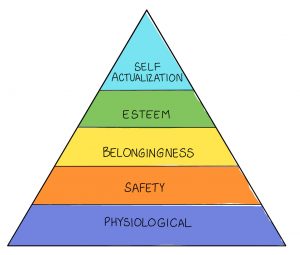3 Motivation and Teamwork

Learning Objectives
Objective 1 – Identify how a leader can influence/impact motivation for an individual and a team.
Objective 2:Articulate the essential skills for leading high performing teams.
Have you ever wondered how to convince someone to assist you with a project? Wondered how to work better with a coworker? Or considered ways you could create better relationships with your team members?
As a leader you will have many opportunities to support others in their work as well as contribute to your team as an equal or a manager. To do this well you will need to understand the foundations of motivation and what you can and cannot influence or change. This concept is key! Most leaders think that they can motivate others through gifts and rewards. Much like the “treasure box” for motivating children’s behavior these strategies only work for short periods of time and teach us to only care about the actions that will get rewarded and remember—everyone values different types of rewards.
 What types of “rewards” have you received in your work life? What worked for you? What didn’t? How did your co-workers respond to the rewards? Make a list.
What types of “rewards” have you received in your work life? What worked for you? What didn’t? How did your co-workers respond to the rewards? Make a list.
Let’s start with a bit of theory about what people need to feel safe and effective in doing their job. Maslow’s Hierarchy of Needs theory is that individuals cannot achieve their full potential until their basic and psychological needs are met. For example, it is very difficult to have a meaningful relationship if you don’t feel safe or have no place to rest.
Maslow’s Theory can also be applied to staff and team members. Consider this Hierarchy of Needs

Self-Actualization – achieving your full potential working with children and families. Mentoring, coaching and/or leading others.
Esteem – Feeling like you are positively contributing to the development of each child and/or family you work with. Being recognized by your peers for your contributions.
Belongingness – Creating and maintaining strong bonds with co-workers, contributing to a team, feeling supported and trusted.
Safety – Feeling secure in your job, understanding safety requirements and how to seek assistance if needed, feeling safe and free from harassment or bullying.
Physiological – Getting breaks as needed and according to employment laws, having the resources needed to perform at your best, having basic employment practices in place to protect you.

Think about your current or most recent job. Where would you rank yourself on the hierarchy of needs? What examples come to mind? Now reflect on your staff/team members. Where would you rank them on the hierarchy of needs? Why?
Ok, we’ve got you thinking about the levels of job satisfaction and what kinds of rewards work and don’t work. Let’s take a quick look at what actually motivates people.
Here are some basic principles of motivation:
- We all have needs that aren’t met, and it is these unmet needs that motivate us.
- We will strive to fulfill our needs by acting in ways that we believe will lead to the outcome we want.
- A person’s greatest ability to have an effect on another’s motivation is at the levels of security, the sense of belonging and self-esteem.
- The ways in which we express or try to fulfill our needs can vary widely based on our cultural perspective.
Let’s unpack these!
An unsatisfied need doesn’t have to be something negative! You could be a team member who is looking to grow into a new position or someone who feels disconnected and wants to improve your peer relationships. Whatever the unsatisfied need, it is important to identify what it is so you can get/offer the support needed.
Most of us will go to great lengths to ensure our unmet need is met. Sometimes that can mean frustrated or angry behaviors. Unfortunately, if we only respond to the team member who gets upset all the time, then that is how some team members will behave. Remember adults are far more skilled at behaviors than children and often don’t hesitate to use the behavior that works, regardless of its impact on those around them. Not because they are bad people, but because it is very difficult to understand our own unmet needs and admit them.
As a leader your greatest impact is at those hierarchy of needs levels of psychological, safety, and belonging. You can support others through coaching or mentoring. You can make sure that processes are in place and that they are aware of them. You can ensure that others feel welcome and appreciated. Remember though, everyone has different values and beliefs and what works for one team member may not work for another!

How do you think culture, values and belief system influence what we need? Or how do you think our personal biases play a role in how we view what we think or need? For example, if you have one team member who speaks to you regularly about what they need and why and you have another team member whose values and belief system includes not challenging an authority figure how can you make sure to meet both their needs?
It is important to recognize and understand the influence that values and beliefs have on motivation. So what are the differences between values and beliefs?
- Values help define and prioritize what is important.
- Values are established typically by adolescence.
- Values are unlikely to be changed from outside influence.
What does this mean for leaders? It means your values and another team member’s values are not likely to change. It also means that you will most likely have shared values that you and others can build a collective understanding on. For example, you probably all value the positive development of children. You may all value supporting families, continuing your education, and quality learning environments. The difference is that some of you will value one of those over another…and that is ok! The point is that you will not likely be able to change someone’s values through influence as a leader.
Beliefs, on the other hand, can and do change as we grow and experience new things. We emerge from our teenage years with a set of beliefs about the world and who we are in it. As we age and grow these beliefs will change as we take in and understand new information and experiences. Beliefs can also be influenced by others such as trusted family or friends, community members, co-workers, or cultural leaders. Think about when you were younger and what you believed vs. what you believe today.
from our teenage years with a set of beliefs about the world and who we are in it. As we age and grow these beliefs will change as we take in and understand new information and experiences. Beliefs can also be influenced by others such as trusted family or friends, community members, co-workers, or cultural leaders. Think about when you were younger and what you believed vs. what you believe today.
As a leader, you can influence the beliefs of others. Let’s take the case of a new team member joining your team. This new team member believes that the best way to teach a child how to get to sleep during nap time is to let them “figure it out–or cry it out”. As a leader in ECE, you know that children need to be guided and some children need support from trusting adults to go to sleep. You can support the new team member’s change in beliefs by educating them on developmentally appropriate practice, modeling and coaching.
 How have your beliefs about working with children and families grown or changed? What has led you to a different understanding? Education? Experience? A good leader?
How have your beliefs about working with children and families grown or changed? What has led you to a different understanding? Education? Experience? A good leader?
People are successfully or unsuccessfully rewarded through a variety of strategies in the workplace. Everyone has unmet needs that can be complicated and even unclear to us. The motivator that works most effectively and leads to further growth is the ability to assist others to feel secure, esteemed, and that they belong. The tricky piece is in sorting out what we and others value and believe in order to correctly identify unmet needs and address them. As we will now explore, effective leaders have a clear understanding of what is within their scope of control and what they cannot control when it comes to motivating other people.
Motivation and Leadership
There are a few things to consider when you look at motivation and leadership. It is not just the leader’s responsibility to motivate others. Remember, motivation comes from within and is different for each team member. Leaders CAN influence the working environment, resources that are available, and how others spend their time. Effective leaders focus on the factors that are within their control and work to reduce negative influences on the team’s motivation.
Example
You have an ethical responsibility to treat all team members in a fair manner that meets team needs as well as supporting individuals. This can be one of the most difficult parts of being a leader; balancing the needs of the many against the needs of 1 or 2.
The tool we use for sorting out dilemmas, understanding who has the problem, and if solutions are related to motivation, leadership, or something beyond everyone’s control is the National Association for the Education of Young Children (NAEYC) Code of Ethical Conduct. Successful leaders use the NAEYC Code of Ethical Conduct to assist them in making decisions when an ethical dilemma is present. Ethical dilemmas are those instances when there is no clear-cut answer and that your choices for resolution are in conflict with each other.
Some things to remember are:
- Sometimes there is not a clear answer to a problem.
- Sometimes the choices that you have for supporting others can be in direct conflict with each other.
- Sometimes you know what you should do but are reluctant to do it.
- There is a fine line between motivating someone and manipulating them. Manipulation is not an ethical action for any leader.
You also need to take into account that culture plays an important role in motivation. Many cultures have a collectivist view where the team members and leader are responsible to each other and the power is in the connectedness of the team. American culture values independence and the rights of each team member. These differences in values can create opportunities for growth and reflection for all team members as well as potential conflict.
- Independent team members may value rewards, kudos, and recognition.
- Collectivist team members may value positive outcomes, long term goals, and team recognition.
Motivation Strategies
There are many strategies you can use to motivate your team members! Let’s look at some for each level.
Self- Actualization (doing work that uses your talents) – Providing opportunities to coach others, opportunities to lead team meetings or work on special projects.
Esteem – Recognizing staff for their contributions in a sincere way that highlights their impact on children and families. Providing opportunities for staff to be “experts” on topics and sending other staff to them for advice.
Belongingness – Creating and maintaining team agreements, providing opportunities for teams to meet and celebrate their differences and contributions, holding team members accountable.
Safety – Creating policies and processes that ensure a safe and harassment-free work environment. Having reporting policies and processes in place to support staff when needed. Providing training and resources.
Physiological – Providing predictable schedules, keeping teachers in the same class, establishing routines and rhythms for the program. Just like children, we need to have routines and predictability so we are comfortable to learn and grow.
Teamwork
Learning Objective
Great teams start with great leaders—and that is not always the person that is in charge. Effective teams rely on both a leader and the rest of the team to work together to achieve their goals. Early Childhood Education has many opportunities for working in teams: from classroom teams, to functional teams (everyone doing the same job such as home visitors), to program teams. In fact, you will most likely work in at least three different teams as a staff member in ECE. That is a lot of teamwork!
Why should you care about teamwork? Because good teams make high quality decisions, manage complexity, and get things done! They are highly motivating and build bonds that can weather the storms of working with children and families.
Let’s start with the basics. A team is…
- A group of individuals who have a common goal.
- Constructed, created.
- Something substantial.
- Takes time to develop and goes through stages.

What different types of teams have you been a part of? Were they positive or negative experiences? Why?
Every team has 5 essential elements:
- Common Goals
- Shared Consequences
- Trust and Respect Amongst Team Members
- Clear Roles
- Effective Leadership
Now let’s break each of these down!
Common goals are important for every team. An effective leader clarifies and states the goals and keeps those goals in front of everyone, so the team knows what it is working towards. These goals can be set with the team or sometimes they are set for the team. In both cases, it is important for each team member to understand the goal so they can do the work needed to meet that goal.
Shared consequences provide each team member with an understanding of how their work impacts the shared goal. Consequences can be positive—everyone is recognized for their efforts when the goal is met. OR Consequences can be negative—a non-performing team member is asked to leave the team or goals are not met. Regardless if they are positive or negative consequences, each team member needs to feel that the consequences are shared equally with all team members.
Trust and respect are crucial for well-functioning teams. Team members need to be able to trust that they can express their views and opinions and that their fellow team members will respect them. They need to feel confident that discussing differing views and opinions is part of the process of working towards goals and that they can make mistakes and learn from those mistakes. They need to trust the leader is there to support and guide them.
that they can express their views and opinions and that their fellow team members will respect them. They need to feel confident that discussing differing views and opinions is part of the process of working towards goals and that they can make mistakes and learn from those mistakes. They need to trust the leader is there to support and guide them.
Clear roles and responsibilities are also important. Great team leaders carefully consider what each team member can do to support the goals and then the leader effectively communicates what the role and responsibilities are. This can also be an opportunity for team members to weigh in and build a collective understanding of each role on the team.
Finally, effective team leadership is all of these things and more! As a team leader, you set the vision for the work and provide the tools and resources needed to perform the work. You are there to provide support and guidance when things go wrong.

Recall an instance that you were on a team that was unsuccessful or that struggled.? Why do you think that is?
There are 4 stages that teams go through and these can have many different labels. We are going to refer to these stages as…
- Testing the Waters
- Team Control
- Getting Organized
- The Effective Team
Testing the waters includes understanding the vision, goals, and structure of the team. People understand their roles and responsibilities and learn how the team works. On the surface things seem to be going well. But the team has not hit any major obstacles yet.
Team control is when the official and unofficial leaders are recognized. Teams may have someone who convenes them and dictates the work they are to do. They will also, most likely, have a team member who leads the task or day to day actions needed. Other unofficial leaders may be someone with a specific skills set, expertise, or point of view.
Getting organized. For this stage, the questions a team must answer—and many of the things we have already learned about in this module—come into practice. Teams decide on things such as communication, timelines, responsibilities, and consequences. Team members feel they know each other well and can navigate this stage fairly easily in most cases.
The Effective Team is the team that seems to magically get things done. They understand their roles and how they contribute and seek feedback from each other. They trust and respect the other team members and there is a sense of support and understanding.

Have you experienced any or all of these team stages? How did that go for you? Is there one stage you think is more important than the others? Why?
What Leaders Can Do in Each Stage
- Testing the waters: leaders can support team members by casting the vision and working collaboratively to establish the goals, roles, and responsibilities. Leaders can conduct get-to-know-you activities so team members learn about each other’s preferences, strengths, and contributions. This is a great opportunity to model the behaviors you wish to see in your team members!
- Team control: establish who is leading what as well as who team members can go to for advice and supports if the team leader is not available. If you are mentoring another as they explore an opportunity to learn leadership skills, you will want to monitor things closely and provide support as needed.
- Getting organized: provide guidance and a framework of expectations for communication and “how” the work will get accomplished. While most team members will contribute their ideas at this stage, it is the job of the leader to make sure the strategies align with the vision and goals and that the work will be accomplished.
- Effective team: it can be tempting for leaders to move on to other tasks or fires that need to be put out. It can be hazardous to ignore a well-functioning team because they can begin to feel under-appreciated. Or worse, there could be some issue that comes up and if not handled quickly turns into one of those fires that needs to be put out! Effective teams need to be continually cultivated and nurtured.
Essential Questions for Successful Teams
There are a couple of essential questions that teams must answer in order to be successful. These questions can be answered by the leader ahead of time or better yet, as facilitated discussion when a team is first formed. Once these questions are answered it can be important to revisit the questions when there are challenges with the team and orientate new team members when they first join the team.
- How do we work through our problems? Do we bring them to the team leader? Do we try to solve them first on our own? Do we talk about them in team meetings?
- What do we need from each other as team members to be successful? Do we need opportunities to practice our skills? Time to learn and grow? Do we want feedback and if so, how often and what does feedback look like to each person?
- How do we handle it when a team member is not fulfilling their responsibilities? Do we bring it to our team leader? Do we offer advice and help?
- How do we communicate? Do we keep a program log book for notes? Do we send emails and texts? Do we schedule regular meetings?
The answers to these questions can be different for many reasons—including an individual’s culture and values. Remember, we can’t change a person’s values but we can influence their behaviors. It is important to set an expectation of inclusiveness and the value of diverse views can have on positive outcomes. If everyone is in agreement all of the time you may miss out on important pieces that could make the team’s goals even better!
A Note About Team Building
While there are many different resources available to give you team-building ideas and exercises, it is important to note that team-building activities are most effective when they align with the culture of the organization and are supported afterwards with meaningful interactions in the workplace. Weekend retreats with games and activities can be fun but they alone do not create dynamic and amazing teams. Creating moments and activities that connect to the philosophy and values of the organization build teams that understand and are connected to the important work of supporting children and families. Team building should always be thoughtful and intentional and provide team members with opportunities to get to know their fellow team members in a meaningful way.
Examples
- A curriculum planning meeting where each team member shares what their hobbies and interests are and brainstorms ideas for curriculum activities.
- A team meeting where baby pictures are posted and team members get to guess who is who. This can then carry over to a discussion about favorite childhood memories and how our values were shaped as we grow up.
- Problem solving team meeting where team members share a challenge or an issue and the group members collectively work together to offer solutions and support. The team members then follow up to offer support if needed.
As you can see from these examples, being a good team member and having an effective team is more than just a weekend retreat. It is about caring and nurturing relationships and meaningful opportunities to connect and learn more about each other. When we feel that our team is invested in our success we become more invested in our team. This creates interconnectedness and belonging which are powerful motivators that can support and sustain a team through issues, challenges, and successes.
Citations
McLeod. (2020). Maslow’s Hierarchy of Needs. Simply Psychology. https://www.simplypsychology.org/maslow.html

